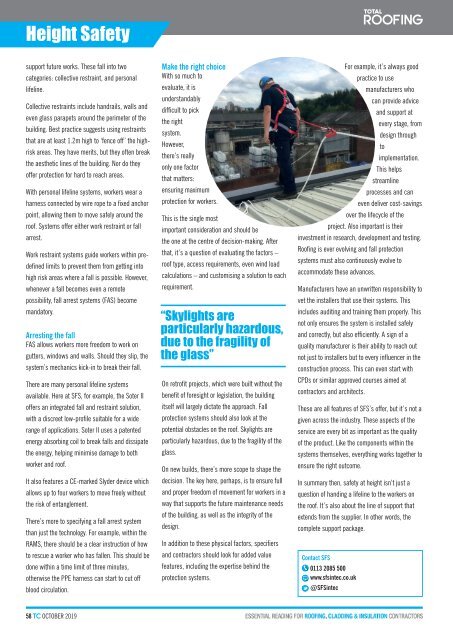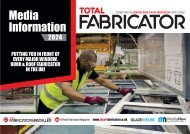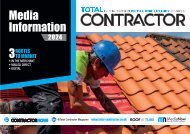October 2019
Create successful ePaper yourself
Turn your PDF publications into a flip-book with our unique Google optimized e-Paper software.
Height Safety<br />
support future works. These fall into two<br />
categories: collective restraint, and personal<br />
lifeline.<br />
Collective restraints include handrails, walls and<br />
even glass parapets around the perimeter of the<br />
building. Best practice suggests using restraints<br />
that are at least 1.2m high to ‘fence off’ the highrisk<br />
areas. They have merits, but they often break<br />
the aesthetic lines of the building. Nor do they<br />
offer protection for hard to reach areas.<br />
With personal lifeline systems, workers wear a<br />
harness connected by wire rope to a fixed anchor<br />
point, allowing them to move safely around the<br />
roof. Systems offer either work restraint or fall<br />
arrest.<br />
Work restraint systems guide workers within predefined<br />
limits to prevent them from getting into<br />
high risk areas where a fall is possible. However,<br />
whenever a fall becomes even a remote<br />
possibility, fall arrest systems (FAS) become<br />
mandatory.<br />
Arresting the fall<br />
FAS allows workers more freedom to work on<br />
gutters, windows and walls. Should they slip, the<br />
system’s mechanics kick-in to break their fall.<br />
There are many personal lifeline systems<br />
available. Here at SFS, for example, the Soter II<br />
offers an integrated fall and restraint solution,<br />
with a discreet low-profile suitable for a wide<br />
range of applications. Soter II uses a patented<br />
energy absorbing coil to break falls and dissipate<br />
the energy, helping minimise damage to both<br />
worker and roof.<br />
It also features a CE-marked Slyder device which<br />
allows up to four workers to move freely without<br />
the risk of entanglement.<br />
There’s more to specifying a fall arrest system<br />
than just the technology. For example, within the<br />
RAMS, there should be a clear instruction of how<br />
to rescue a worker who has fallen. This should be<br />
done within a time limit of three minutes,<br />
otherwise the PPE harness can start to cut off<br />
blood circulation.<br />
Make the right choice<br />
With so much to<br />
evaluate, it is<br />
understandably<br />
difficult to pick<br />
the right<br />
system.<br />
However,<br />
there’s really<br />
only one factor<br />
that matters:<br />
ensuring maximum<br />
protection for workers.<br />
This is the single most<br />
important consideration and should be<br />
the one at the centre of decision-making. After<br />
that, it’s a question of evaluating the factors –<br />
roof type, access requirements, even wind load<br />
calculations – and customising a solution to each<br />
requirement.<br />
“Skylights are<br />
particularly hazardous,<br />
due to the fragility of<br />
the glass”<br />
On retrofit projects, which were built without the<br />
benefit of foresight or legislation, the building<br />
itself will largely dictate the approach. Fall<br />
protection systems should also look at the<br />
potential obstacles on the roof. Skylights are<br />
particularly hazardous, due to the fragility of the<br />
glass.<br />
On new builds, there’s more scope to shape the<br />
decision. The key here, perhaps, is to ensure full<br />
and proper freedom of movement for workers in a<br />
way that supports the future maintenance needs<br />
of the building, as well as the integrity of the<br />
design.<br />
In addition to these physical factors, specifiers<br />
and contractors should look for added value<br />
features, including the expertise behind the<br />
protection systems.<br />
For example, it’s always good<br />
practice to use<br />
manufacturers who<br />
can provide advice<br />
and support at<br />
every stage, from<br />
design through<br />
to<br />
implementation.<br />
This helps<br />
streamline<br />
processes and can<br />
even deliver cost-savings<br />
over the lifecycle of the<br />
project. Also important is their<br />
investment in research, development and testing.<br />
Roofing is ever evolving and fall protection<br />
systems must also continuously evolve to<br />
accommodate these advances.<br />
Manufacturers have an unwritten responsibility to<br />
vet the installers that use their systems. This<br />
includes auditing and training them properly. This<br />
not only ensures the system is installed safely<br />
and correctly, but also efficiently. A sign of a<br />
quality manufacturer is their ability to reach out<br />
not just to installers but to every influencer in the<br />
construction process. This can even start with<br />
CPDs or similar approved courses aimed at<br />
contractors and architects.<br />
These are all features of SFS’s offer, but it’s not a<br />
given across the industry. These aspects of the<br />
service are every bit as important as the quality<br />
of the product. Like the components within the<br />
systems themselves, everything works together to<br />
ensure the right outcome.<br />
In summary then, safety at height isn’t just a<br />
question of handing a lifeline to the workers on<br />
the roof. It’s also about the line of support that<br />
extends from the supplier. In other words, the<br />
complete support package.<br />
Contact SFS<br />
0113 2085 500<br />
www.sfsintec.co.uk<br />
@SFSintec<br />
58 TC OCTOBER <strong>2019</strong>

















